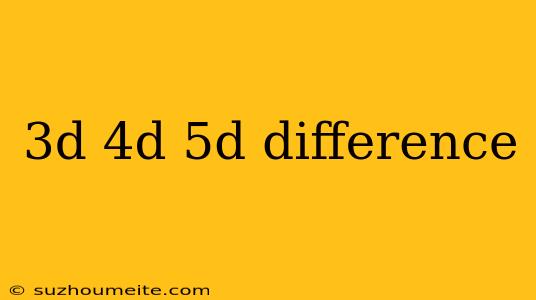3D, 4D, 5D: Understanding the Differences
In the realm of computer-aided design (CAD), engineering, and architecture, terms like 3D, 4D, and 5D are frequently thrown around. But what do these terms really mean, and how do they differ from one another? In this article, we'll delve into the world of dimensions and explore the distinct characteristics of 3D, 4D, and 5D.
What is 3D?
3D (Three-Dimensional) represents a three-dimensional space where objects have length, width, and depth. In a 3D environment, objects are visualized and manipulated using three perpendicular axes (x, y, and z). This dimension is commonly used in computer-aided design (CAD), 3D modeling, and simulation.
Key characteristics of 3D:
- Objects have length, width, and depth
- 3 perpendicular axes (x, y, and z)
- Used in CAD, 3D modeling, and simulation
What is 4D?
4D (Four-Dimensional) builds upon the 3D concept by adding an extra dimension: time. In a 4D environment, objects not only have length, width, and depth but also a temporal component. This dimension is often used in construction, architecture, and project management to visualize and analyze the project timeline.
Key characteristics of 4D:
- Objects have length, width, depth, and time
- Adds a temporal component to 3D
- Used in construction, architecture, and project management
What is 5D?
5D (Five-Dimensional) takes the 4D concept a step further by incorporating an additional dimension: cost. In a 5D environment, objects have length, width, depth, time, and cost. This dimension is particularly useful in construction and project management, where cost estimation and budgeting are critical components.
Key characteristics of 5D:
- Objects have length, width, depth, time, and cost
- Adds a cost component to 4D
- Used in construction, project management, and cost estimation
Key differences between 3D, 4D, and 5D:
| Dimension | Characteristics |
|---|---|
| 3D | Length, width, depth |
| 4D | Length, width, depth, time |
| 5D | Length, width, depth, time, cost |
In summary, 3D represents a three-dimensional space, 4D adds time to the mix, and 5D incorporates cost. Understanding the differences between these dimensions is essential for professionals working in industries that rely on CAD, simulation, and project management.
By grasping the unique characteristics of each dimension, individuals can better navigate the complexities of their respective fields and make more informed decisions.
